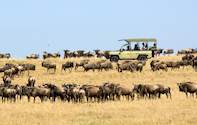
Serengeti Safari Highlights
The Great Migration, post card Africa, balloon safari, wildlife safariThe Lay of the Land
The Serengeti plains are the setting for the most dramatic wildlife spectacle on the planet. Known as the 'Greatest Show on Earth' the wildebeest migration sees more than a million wildebeest, zebras and gazelles in their great circular migration across the plains and acacia woodlands. Huge columns of advancing zebras and ungainly wildebeest stretch as far as the eye can see, and lions and hyenas lie in wait all along the route. In the southeastern part, during the summer months of December to March the open plains are awash with wildebeest, zebra and gazelles, which prefer the short palatable grass in this area.
This is the time of aplenty, of pregnancy and of birth. The central area is savannah with scattered acacia trees and rocky outcrops. The Seronera Valley is in the centre of the Serengeti, named after the Seronera River, which provides the only source of permanent water in this area. Millions of wildebeest, zebra and gazelles pass through this area during April and May, as the herds start to move north in the search for better grazing.
The Great Migration

The great migration is a circular movement so they also pass again through this area, dependant on the rains, around late November and December. The west has extensive woodland and black clay plains; here you can find large herds of buffalo and elephants. In this area is the Grumeti River, where exceedingly large crocodiles live. The yearly wildebeest river crossing provides the crocodiles with their annual feed. The migration is usually in this area around June to July.
The northern part of the Serengeti is a hilly, wooded grassland that borders the Masai Mara. Around June to October the migration herds tend to bunch together as they reach their most serious obstacle to get to the fresh grazing, the Mara River.
To get into the Masai Mara the herds have to cross this river, which after the rains, is fast flowing and swollen, with of course the waiting hungry crocodiles and large cats which wait for some easy prey. The great herds cross into the Masai Mara as it receives more rainfall than the Serengeti. The antelope are constantly feeding as they traverse from one area to another, continually looking for better grazing. The northern parts of the Serengeti is rich with wildlife as they head in and out of Tanzania.
Serengeti Safari Activities
Game drives, cultural interpretations [Maasai], trips to Lake Victoria, balloon safari over the Serengeti National Park.Strategically placed safari lodges all over the Serengeti take advantage of the huge numbers of animals passing by at certain times of the year. Each area of the Serengeti does however have resident animals that don't migrate as such, allowing an exceptional year round safari experience.Of the Migration and the Maasai

Serengeti National Park Safari Lodges
See Serengeti National Park Safari Lodges in Tanzania.

 One of the most fascinating acts of nature, the Serengeti Migration is long familiar with wildebeest migration. Few words can describe this ...
One of the most fascinating acts of nature, the Serengeti Migration is long familiar with wildebeest migration. Few words can describe this ... Serengeti National Park Safari Lodges in Tanzania. The Serengeti National Park lies in northwestern Tanzania. See Serengeti National Park sa...
Serengeti National Park Safari Lodges in Tanzania. The Serengeti National Park lies in northwestern Tanzania. See Serengeti National Park sa... Often referred to as the most beautiful balloon ride in the world, the Serengeti Balloon Safari is one certainly one of the most sought afte...
Often referred to as the most beautiful balloon ride in the world, the Serengeti Balloon Safari is one certainly one of the most sought afte... Of all the iconic African names the Serengeti is arguably the most recognized. The name inspires images of wide open plains, big skies and a...
Of all the iconic African names the Serengeti is arguably the most recognized. The name inspires images of wide open plains, big skies and a... Violent death is not confined to the meek masses, the multitude of grazers. The predators too have to fight for their right to live, to eat ...
Violent death is not confined to the meek masses, the multitude of grazers. The predators too have to fight for their right to live, to eat ... It is a fact that in the Serengeti insects (and the attendant insectivores) way outnumber the herbivores. The Secret Lives of Termites...
It is a fact that in the Serengeti insects (and the attendant insectivores) way outnumber the herbivores. The Secret Lives of Termites...